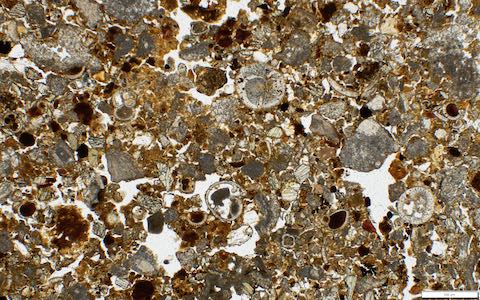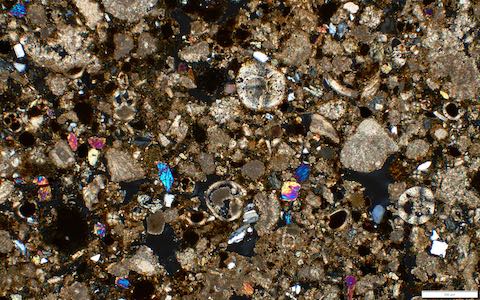

| None (0) | Minor (1) | Few (2) | Common (3) | Frequent (4) | Major (5) | Very Dominant (6) |
| 0% | 0-5% | 5-15% | 15-30 % | 30-50% | 50-70% | 70-100% |
| Name | Cal. | Quartz | Feldspar | Pyroxene | Amphibole | Opaques | Olivine | Biotite | Muscovite | Epidote | Garnet/ Spinel | Ig./Met. Rocks | Sed. Rocks | Grog | Lithics/ Region |
|---|---|---|---|---|---|---|---|---|---|---|---|---|---|---|---|
| tpr458 | 6 | 2 | 2 | 2 | 0 | 1 | 0 | 0 | 0 | 0 | 0 | 0 | 0 | 0 | na |
| Huon calcareous | 5 | 0 | 1 | 0 | 0 | 1 | 0 | 0 | 0 | 0 | 0 | 0 | 0 | 0 | PNG |
| Slide | Fabric | Possible Origin | Cal. | Quartz | Feldspar | Pyroxene | Amphibole | Opaques | Olivine | Biotite | Muscovite | Epidote | Garnet/ Spinel | Ig./Met. Rocks | Sed. Rocks | Grog | Lithics |
|---|---|---|---|---|---|---|---|---|---|---|---|---|---|---|---|---|---|
| IL_1_95 | tpr458 (Huon calcareous) | Nambariwa | 5 | 0 | 2 | 2 | 0 | 1 | 0 | 0 | 0 | 0 | 0 | 0 | 0 | 0 | na |


CAUTION: Section less than 30microns. Nambariwa clay. Consists of shelly fragments (more than 50%) of different sizes up to 2 mm. Some of the fragments show excellent cellular structure indicating the presence of coral, gastropods and bivalves. Other shelly fragments consist of very fine grained carbonate. Pyroxene grains (<5%) are colourless, angular and less than 0.2 mm across. There is a trace of spinel, minor angular feldspar (less than 0.2 mm across) and brown clay.